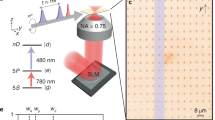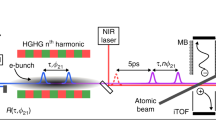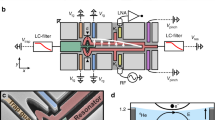Abstract
Controlling the interactions between atoms with external fields opened up new branches in physics ranging from strongly correlated atomic systems to ideal Bose1 and Fermi2 gases and Efimov physics3,4. Such control usually prepares samples that are stationary or evolve adiabatically in time. In contrast, in molecular physics, external ultrashort laser fields are used to create anisotropic potentials that launch ultrafast rotational wave packets and align molecules in free space5. Here we combine these two regimes of ultrafast times and low energies. We apply a short laser pulse to the helium dimer, a weakly bound and highly delocalized single bound state quantum system. The laser field locally tunes the interaction between two helium atoms, imparting an angular momentum of 2ℏ and evoking an initially confined dissociative wave packet. We record a video of the density and phase of this wave packet as it propagates from small to large internuclear distances. At large internuclear distances, where the interaction between atoms is negligible, the wave packet is essentially free. This work paves the way for future tomography of wave-packet dynamics and provides the technique for studying exotic and otherwise hardly accessible quantum systems, such as halo and Efimov states.
This is a preview of subscription content, access via your institution
Access options
Access Nature and 54 other Nature Portfolio journals
Get Nature+, our best-value online-access subscription
$29.99 / 30 days
cancel any time
Subscribe to this journal
Receive 12 print issues and online access
$209.00 per year
only $17.42 per issue
Buy this article
- Purchase on Springer Link
- Instant access to full article PDF
Prices may be subject to local taxes which are calculated during checkout




Similar content being viewed by others
Data availability
All experimental data has been archived at the Goethe-University of Frankfurt am Main and is available upon request. Source data are provided with this paper.
References
Anderson, M. H., Ensher, J. R., Matthews, M. R., Wieman, C. E. & Cornell, E. A. Observation of Bose–Einstein condensation in a dilute atomic vapor. Science 269, 198–201 (1995).
DeMarco, B., Bohn, J. L., Burke, J. P., Holland, M. & Jin, D. S. Measurement of p-wave threshold law using evaporatively cooled fermionic atoms. Phys. Rev. Lett. 82, 4208–4211 (1999).
Efimov, V. Energy levels arising from resonant two-body forces in a three-body system. Phys. Lett. B 33, 563–564 (1970).
Kraemer, T. et al. Evidence for Efimov quantum states in an ultracold gas of caesium atoms. Nature 440, 315–318 (2006).
Stapelfeldt, H. & Seideman, T. Colloquium: Aligning molecules with strong laser pulses. Rev. Mod. Phys. 75, 543–557 (2003).
Chin, C., Grimm, R., Julienne, P. & Tiesinga, E. Feshbach resonances in ultracold gases. Rev. Mod. Phys. 82, 1225–1286 (2010).
Kotochigova, S. Controlling interactions between highly magnetic atoms with Feshbach resonances. Rep. Prog. Phys. 77, 093901 (2014).
Kurizki, G., Mazets, I. E., O’Dell, D. H. J. & Schleich, W. P. Bose–Einstein condensates with laser-induced dipole–dipole interactions beyond the mean-field approach. Int. J. Mod. Phys. B 18, 961–974 (2004).
Cencek, W. et al. Effects of adiabatic, relativistic, and quantum electrodynamics interactions on the pair potential and thermophysical properties of helium. J. Chem. Phys. 136, 224303 (2012).
Zeller, S. et al. Imaging the He2 quantum halo state using a free electron laser. Proc. Natl Acad. Sci. USA 113, 14651–14655 (2016).
Friedrich, B., Gupta, M. & Herschbach, D. Probing weakly-bound species with nonresonant light: dissociation of He2 induced by rotational hybridization. Collect. Czech. Chem. Commun. 63, 1089–1093 (1998).
Lemeshko, M. & Friedrich, B. Probing weakly bound molecules with nonresonant light. Phys. Rev. Lett. 103, 053003 (2009).
Wei, Q., Kais, S., Yasuike, T. & Herschbach, D. Pendular alignment and strong chemical binding are induced in helium dimer molecules by intense laser fields. Proc. Natl Acad. Sci. USA 115, E9058–E9066 (2018).
Guan, Q. & Blume, D. Electric-field-induced helium–helium resonances. Phys. Rev. A 99, 033416 (2019).
Lemeshko, M. & Friedrich, B. Fine-tuning molecular energy levels by nonresonant laser pulses. J. Phys. Chem. A 114, 9848–9854 (2010).
Aganoglu, R., Lemeshko, M., Friedrich, B., González-Férez, R. & Koch, C. Controlling a diatomic shape resonance with non-resonant light. Preprint at https://arxiv.org/abs/1105.0761 (2011).
Lemeshko, M. Shaping interactions between polar molecules with far-off-resonant light. Phys. Rev. A 83, 051402 (2011).
González-Férez, R. & Koch, C. P. Enhancing photoassociation rates by nonresonant-light control of shape resonances. Phys. Rev. A 86, 063420 (2012).
Lemeshko, M., Krems, R. V., Doyle, J. M. & Kais, S. Manipulation of molecules with electromagnetic fields. Mol. Phys. 111, 1648–1682 (2013).
Tomza, M. et al. Interatomic potentials, electric properties and spectroscopy of the ground and excited states of the Rb2 molecule: ab initio calculations and effect of a non-resonant field. Mol. Phys. 111, 1781–1797 (2013).
Crubellier, A., González-Férez, R., Koch, C. P. & Luc-Koenig, E. Asymptotic model for shape resonance control of diatomics by intense non-resonant light: universality in the single-channel approximation. New J. Phys. 17, 045020 (2015).
Balanarayan, P. & Moiseyev, N. Strong chemical bond of stable He2 in strong linearly polarized laser fields. Phys. Rev. A 85, 032516 (2012).
Nielsen, E., Fedorov, D. V. & Jensen, A. S. Efimov states in external fields. Phys. Rev. Lett. 82, 2844–2847 (1999).
Schöllkopf, W. & Toennies, J. P. Nondestructive mass selection of small van der Waals clusters. Science 266, 1345–1348 (1994).
Maroulis, G., Makris, C., Hohm, U. & Goebel, D. Electrooptical properties and molecular polarization of iodine, I2. J. Phys. Chem. A 101, 953–956 (1997).
Ullrich, J. et al. Recoil-ion and electron momentum spectroscopy: reaction-microscopes. Rep. Prog. Phys. 66, 1463 (2003).
Jagutzki, O. et al. Multiple hit readout of a microchannel plate detector with a three-layer delay-line anode. IEEE Trans. Nucl. Sci. 49, 2477–2483 (2002).
Christian, J. F., Broers, B., Hoogenraad, J. H., van der Zande, W. J. & Noordam, L. D. Rubidium electronic wavepackets probed by a phase-sensitive pump-probe technique. Opt. Commun. 103, 79–84 (1993).
Kunitski, M. et al. Double-slit photoelectron interference in strong-field ionization of the neon dimer. Nat. Commun. 10, 1 (2019).
Yudkin, Y., Elbaz, R., Giannakeas, P., Greene, C. H. & Khaykovich, L. Coherent superposition of Feshbach dimers and Efimov trimers. Phys. Rev. Lett. 122, 200402 (2019).
Acknowledgements
We thank B. Friedrich for inspiring this work over many years and M. Lemeshko for many helpful discussions and calculations. The experimental work was supported by Deutsche Forschungsgemeinschaft (DFG). This work used the OU Supercomputing Center for Education and Research (OSCER) at the University of Oklahoma. Q.G. and D.B. acknowledge support by the US National Science Foundation (grant no. PHY-1806259).
Author information
Authors and Affiliations
Contributions
M.K., H.M., J.H., S.E., S.Z., A.K., M.S., L.P.H.S. and T.J. contributed to the experiment. M.K. and R.D. analysed the experimental data. Q.G. and D.B. developed the theory. Q.G. performed the calculations. All authors contributed to the manuscript.
Corresponding authors
Ethics declarations
Competing interests
The authors declare no competing interests.
Additional information
Peer review information Nature Physics thanks Daniel Rolles and the other, anonymous, reviewer(s) for their contribution to the peer review of this work.
Publisher’s note Springer Nature remains neutral with regard to jurisdictional claims in published maps and institutional affiliations.
Supplementary information
Supplementary Information
Supplementary Figs. 1–21 and Discussion.
Supplementary Video 1
The video shows the field-induced temporal evolution of the change of the probability density \(|\Psi_{\text{obs}}(\vec{R},t)|^{2}-|\Psi_{\text{GS}}(R)|^{2}\) of He2 as a \((R_{\parallel},R_{\perp})\) projection in cylindrical coordinates. \(R_{\parallel}\) and \(R_{\perp}\) are the parallel and perpendicular components of the internuclear distance vector \(\vec{R}\) with respect to the laser field polarization. Left: original experimental data. Right: the same as on the left but after applying a low-pass filter in Fourier space.
Source data
Source Data Fig. 2
Panels b and c.
Source Data Fig. 3
Panels a and b.
Rights and permissions
About this article
Cite this article
Kunitski, M., Guan, Q., Maschkiwitz, H. et al. Ultrafast manipulation of the weakly bound helium dimer. Nat. Phys. 17, 174–178 (2021). https://doi.org/10.1038/s41567-020-01081-3
Received:
Accepted:
Published:
Issue Date:
DOI: https://doi.org/10.1038/s41567-020-01081-3
This article is cited by
-
Reshaped three-body interactions and the observation of an Efimov state in the continuum
Nature Communications (2024)
-
Gently stirred not shaken
Nature Physics (2021)



